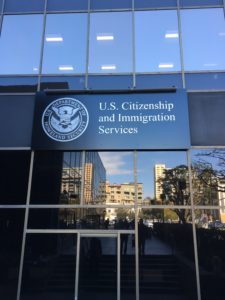 The USCIS Field Office in Minneapolis approved our clients’ joint Form I-751 petition to remove conditions on residence, even though they lived apart in different states during the marriage and had just moved in together at the time of the interview. A timely response to the Request for Evidence and in-depth preparation for the I-751 interview were essential to getting the approval.
The USCIS Field Office in Minneapolis approved our clients’ joint Form I-751 petition to remove conditions on residence, even though they lived apart in different states during the marriage and had just moved in together at the time of the interview. A timely response to the Request for Evidence and in-depth preparation for the I-751 interview were essential to getting the approval.
When the U.S. citizen’s I-130 petition and the beneficiary’s I-485 green card application were approved years earlier, the couple resided together. But the beneficiary later moved to another state where job opportunities were better and the living expenses were lower. The couple lived apart for about three years following their marriage. The U.S. citizen delayed relocating with his spouse to fulfill family obligations in his home state. In the meantime, they made a few trips to visit each other and kept up long-distance communication through telephone calls and text messages.
Explanatory Response to Request for Evidence
On their own, the couple filed the joint Form I-751 petition with their tax returns and a few affidavits as supporting evidence. The conditional resident contacted me, for the first time, when she received a Request for Evidence from USCIS instructing her to submit more evidence to show she and her spouse entered the marriage in good faith and continue to share a life together.
USCIS noted the evidence should include proof of children as a result of the marriage, evidence of joint residence, documents showing combined financial resources, and affidavits from third parties who have direct knowledge of the relationship.
In the consultation, I described the documentary evidence to submit in lieu of a joint residential lease, joint bills and other proof of a shared residence. I also noted that detailed affidavits from the couple were necessary to explain the compelling reasons for living separately in different states and their concrete plans to move in together where the conditional resident lives.
The Service may waive the interview requirement only when the documentary evidence is enough to support an approval without question. Because the conditional resident and her U.S. citizen spouse would continue to live in separate states at the time the RFE response was due, I explained that an interview with USCIS was likely.
Maintaining separate residences is a serious negative factor to consider when evaluating the bona fide nature of a marriage. USCIS will not approve an I-751 without an interview when there is no proof of a joint residence.
Falsely claiming to live together is a foolish and risky action to take. This makes the conditional resident subject to being charged with INA 212(a)(6)(C)(i)(fraud or willful misrepresentation of material fact to gain U.S. immigration benefits), which is a lifetime inadmissibility bar to receiving permanent residence. In addition, USCIS may conduct an investigation – such as search open source records and make unannounced visits to the claimed residence – to verify whether the couple really lives together. Such investigations may occur at any time while the petition is pending.
Thorough Preparation for I-751 Interview
Eight months after the RFE was issued, USCIS sent the conditional resident an interview notice to complete the Form I-751 processing. At that point, the U.S. citizen had recently relocated and entered into a new lease agreement with his spouse for their shared residence.
The couple contacted me for representation at the I-751 interview. Before agreeing to attend the interview as counsel, we had a telephone consultation in which we discussed the status of their relationship, the re-establishment of their joint residence, and the potential concerns and questions the USCIS officer would likely have at the interview.
I also counseled them on the additional documentary evidence to submit at the interview. This included their joint residential lease, joint bank account statement, joint utility bill, and home property insurance.
After thoroughly preparing them for what to expect, I attended the interview with them a few days later. The USCIS officer interviewed them separately and asked a variety of questions on the premarital courtship, marital history, living arrangements, medical conditions, family dynamics, reasons for the separate residences, the U.S. citizen’s relocation, and current home they share. Their testimonies were credible and overall consistent with each other.
Removal of Conditions on Permanent Residence Following Completion of I-751 Interview
At the end of the interview, the USCIS officer issued a notice stating the petition has been recommended for approval and an approval notice would be mailed if final approval is granted.
A week later, the couple received the official Form I-797, Approval Notice removing the conditions on residence. The 10-year green card was also mailed in a separate correspondence. Because the applicant had received her conditional residence four years ago and remains married to the U.S. citizen petitioner, she already meets the continuous residence requirement for naturalization (U.S. citizenship).
Separate Residences During Marriage Creates an Obstacle to Receiving I-751 Approval
The years of maintaining separate residences made it harder for this otherwise bona fide married couple to receive an I-751 approval. Without evidence of their trips to visit each other and long-distance communications, as well as their own affidavits and third-party affidavits describing their marriage, the interview would have been tougher.
Further preparation on the testimonies and documentary evidence to present at the I-751 interview was also critical to getting the conditions on permanent residence removed. It was important for them to tell the truth about the separate residences instead of offer fabricated information about their living arrangements. Falsifying evidence is one of the quickest ways to end up with inconsistencies and a denial.
With guidance from counsel, the conditional resident received an I-751 approval despite living separately from her U.S. citizen spouse for several years during the marriage.
This is a true success story.
Cheers,
Dyan Williams
Founder & Principal Attorney
Dyan Williams Law PLLC
(612) 225-9900
info@dyanwilliamslaw.com
###
This article provides general information only. It is based on law, regulations and policy that are subject to change. Do not consider it as legal advice for any individual case or situation. Each case is different and case examples do not constitute a prediction or guarantee of success or failure in any other case. The sharing or receipt of this information does not create an attorney-client relationship.

 A USCIS Field Office in Ohio approved our client’s Form I-751 petition with request for waiver of joint filing requirement, despite her not living with the U.S. citizen (who had petitioned for her CR1 spousal immigrant visa) after she arrived in the United States as a conditional resident.
A USCIS Field Office in Ohio approved our client’s Form I-751 petition with request for waiver of joint filing requirement, despite her not living with the U.S. citizen (who had petitioned for her CR1 spousal immigrant visa) after she arrived in the United States as a conditional resident.

